Hurricane eMatrix
List of Activity Sheets » Community support and public health services
Search and Rescue
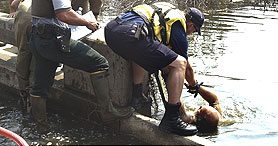
This picture shows actual disaster site work conditions and may not illustrate proper safety and health procedures.
Activity Description
- This activity sheet outlines the hazards to any response and recovery worker who performs search and rescue functions in the first few days after a natural disaster.
- For some operations or situations (e.g., permit-required confined space entry, heavy equipment use) other activity sheets also apply; see related activity sheets below.
- Hurricanes Katrina and Rita (2005) damaged structures and displaced people in several states. More than 49,800 lives were saved and people rescued. After any disaster, search and rescue activities will be the predominant initial response activity. Inspectors and individuals conducting rescue operations move through affected areas to obtain initial damage assessments and search for survivors who are injured or for other reasons unable to reach safety.
- These response and recovery workers are typically the first to encounter the range of hazards created by the disaster. Although individuals conducting search and rescue are typically not responsible for correcting these hazards, they typically perform an initial evaluation and report the location of the hazards they observe.
- These response and recovery workers conduct activities necessary to rescue survivors. In this capacity they might be called upon to provide basic first aid until emergency medical service personnel arrive. They might also need to shift debris or enter confined spaces to reach survivors. Search and rescue activities are performed in vehicles, on foot, or by boat or by divers, depending on the situation in the area being searched.
- Response and recovery workers conducting this operation may be employed by Federal, State, local, and private employers. Review How to Use This Matrix in the introduction for a discussion of how this information may apply to different workers.
About the Activity Sheet
This activity sheet does not provide an in-depth analysis of OSHA standards and regulations and cannot address all hazards. It does not increase or diminish any OSHA requirement or employer obligation under those requirements. It is intended as a guide and quick reference for employers and response and recovery workers. The Matrix captures major activities involved in hurricane response and recovery, highlights many of the hazards associated with them, and recommends beneficial work practices, personal protective equipment (PPE), and other exposure control methods. Employers must evaluate the specific hazards associated with the job/operation at the site where the work is being performed.
Employers are responsible for providing a safe and healthful workplace for their workers. OSHA's role is to assure the safety and health of America's workers by setting and enforcing standards; providing training, outreach, and education; establishing partnerships; and encouraging continual improvement in workplace safety and health.
The Hazard Exposure and Risk Assessment Matrix for Hurricane Response and Recovery Work provides a general overview of particular topics related to current OSHA standards. It does not alter or determine compliance responsibilities in OSHA standards or the Occupational Safety and Health Act of 1970, or the equivalent State Plan standards and requirements. Because interpretations and enforcement policy may change over time, you should consult current OSHA/State Plan administrative interpretations and decisions by the Occupational Safety and Health Review Commission and the courts for additional guidance on OSHA compliance requirements. Employers should modify their procedures as appropriate when additional, relevant information becomes available.
General Recommendations
Key Engineering Controls and Work Practices. See general recommendations document.
Personal Protective Equipment. The general PPE is recommended for all response/recovery tasks/operations; only the additional PPE that may be needed for a specific hazard is noted below.
General PPE includes:
- Hard hat for overhead impact or electrical hazards
- Eye protection with side shields
- Gloves chosen for job hazards expected (e.g., heavy-duty leather work gloves for handling debris with sharp edges and/or chemical protective gloves appropriate for chemicals potentially contacted)
- ANSI-approved protective footwear
- Respiratory protection as necessary—N, R, or P95, filtering facepieces may be used for nuisance dusts (e.g., dried mud, dirt and silt) and mold (except mold remediation). Filters with a charcoal layer may be used for odors.
Recommendations Specific to Hazards Associated with Search and Rescue
Key Engineering Controls and Work Practices
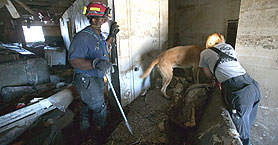
- Limit access/set up controlled access zones until stability and structural integrity is known
- Conduct searches from outside damaged structures to the extent feasible
- Ensure that a competent person evaluates stability of buildings, floors, or rubble piles when access is necessary. A competent person is able to recognize existing and predictable hazardous conditions and has the authority to take prompt corrective measures to eliminate the hazardous conditions
- Install temporary structural support adequate to protect response and recovery workers
- Limit the number of rescue workers and equipment in the space
Key Engineering Controls and Work Practices
- Remove or secure objects (glass, structural members) that may fall while workers work under them
- Use debris netting, sidewalk sheds, canopies, or catch platforms to reduce hazards from falling objects
- Assess the presence, contents, and condition of tanks and equipment that might contain hazardous chemicals, gases, or flammable materials. If the condition of tanks or equipment is suspect, avoid disturbing them
- Use air monitoring equipment to determine if the contents of the tanks or equipment are creating a hazardous atmosphere (e.g., flammable, combustible, corrosive, toxic, or oxygen-deficient). When necessary, provide additional controls (e.g., forced ventilation, respiratory protection)
- Test and purge tanks and equipment that may be impacted by work operations
Key Engineering Controls and Work Practices
- Assume that electrical lines are energized until proven otherwise. Lines and other conductors may become reenergized without warning as utilities are evaluated and restored after a disaster
- Inspect the work area for downed conductors and do not go near, drive over, or otherwise come in contact with them
- Downed electrical conductors can energize other objects, including fences, water pipes, bushes, trees, telephone/CATV/fiber optic cables
- Unless deenergized and visibly grounded, maintain proper distance from overhead electrical power lines (at least 10 feet) and/or provide insulating barriers
- Do not approach any gas leaks; if a gas leak is detected, secure spark-producing devices (e.g., engines, tools, electronic, and communications equipment) and evacuate the area until the leak is secured
- Contact utility company to assist in locating, marking, and shutting off/purging utility lines that may pose a hazard or may be impacted; ensure that lines have been purged as needed before beginning work
Key Engineering Controls and Work Practices
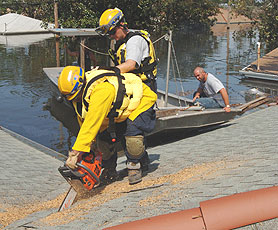
- Before starting, check controls, chain tension, bolts, and handles to ensure proper function and adjustment
- Start the saw on the ground or on another firm support with the brake engaged
- Plan the cut; watch for objects under tension; use extreme care to bring objects safely to the ground. Plan where the object will fall; ensure that the fall area is free of hazards; avoid felling an object into other objects; and ensure that a clear retreat path is provided
- Look for nails, spikes, or other metal objects before cutting
- Clear away dirt, debris, small tree limbs, and rocks from the chain saw's path
- Keep hands on handles and maintain secure footing
- To control or prevent chain saw kickback, push-back, and pull-in, use saws that reduce these dangers through chain breaks, low kickback chains, etc.; do not use the saw's tip and keep any tip guards in place
- Do not cut directly overhead
- Shut off/release throttle prior to retreating
- Shut off or engage chain saw brake when carrying a saw more than 50 feet or crossing hazardous terrain
Additional Personal Protective Equipment
- Chaps
- Hearing protection—see Noise hazard
- Eye protection appropriate for additional impact hazard
- Fall protection, as necessary—see Fall hazard
Key Engineering Controls and Work Practices
- See general recommendations document
- Be on guard for stray animals as they exhibit unpredictable or aggressive behavior
- Unless properly trained, do not attempt to take custody of animals – watch the animal from a safe distance while contacting animal rescue/control personnel
- Use insect repellent containing DEET or Picaridin on exposed skin and wear long pants and a long-sleeved shirt
- Inspect areas for nests and stray animals
- Assume that all snakes are poisonous and that all animals are rabid
Key Engineering Controls and Work Practices
- Follow universal precautions, including washing any areas of the body or clothing that become contaminated with blood or bodily fluids
- Wash hands with soap and water every time gloves are removed. In the absence of soap and water, use an alcohol-based hand cleaner after glove removal. However, wash hands with soap and water as soon as feasible
- Do not wear PPE or clothing that has been damaged or has been penetrated by body fluids
- Report injuries and exposures to body fluid to supervisor
- Decontaminate equipment before reuse; do not reuse gloves or other disposable PPE
Additional Personal Protective Equipment
- Fluid-proof gloves (e.g., latex, nitrile, rubber). Cover with heavy-duty work gloves if potential for cuts and abrasions (e.g., moving debris)
- Protective clothing appropriate for preventing blood penetrating to underlying skin/clothing
Key Engineering Controls and Work Practices
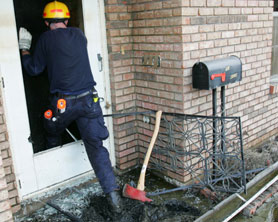
- Use ground-fault circuit interrupters (GFCIs) or double insulated power tools, or implement an assured equipment grounding program
- Inspect power tool condition (including any cords) and verify operation of safety features before use
- Do not use equipment that is defective, such as equipment with inoperable safety switches, missing guards, frayed/cut cords etc.
- Ground power tools properly
- Avoid standing in wet areas when using portable power tools
Additional Personal Protective Equipment
- Hearing protection—see Noise hazard
- Hand protection for cut- and abrasion-control and vibration dampening
- Eye protection appropriate to the impact hazard
Key Engineering Controls and Work Practices
- Limit access/set up controlled access zones
- Use fall protection systems: guardrails, safety nets, or fall arrest systems
- Cover or guard holes and openings as soon as they are created. Covers must support two times the weight (body, equipment, materials) that may be imposed
Additional Personal Protective Equipment
- Personal fall arrest system including harnesses, lanyards, lifelines, connectors, anchorages, and anchor points (as needed)
Key Engineering Controls and Work Practices
- Remove flammable and combustible materials from the area
- Do not perform "hot work" such as welding, cutting, or burning in areas where flammable, combustible, corrosive, or toxic substances are being used, stored, or may otherwise be present
- Maintain a fire watch during all hot work until material has cooled
- Ensure fire extinguishers and extinguishing agents are available in the immediate area
- Provide natural, exhaust, or forced ventilation to control exposure to the metal fumes and other contaminants being generated (e.g., generator exhaust)
- Ensure that pipes and other vessels are purged of hazardous materials
- If welding on materials that potentially contain lead such as painted surfaces and pipes, see the lead hazard in the general recommendations document
Additional Personal Protective Equipment
- Gloves and protective clothing for the activity being performed
- At a minimum, filtered lenses and face-protection as appropriate for the activity being performed
- Respiratory protection based on anticipated exposure to metal fumes, including lead
Key Engineering Controls and Work Practices
- Confined spaces have limited means of entry or exit, are large enough to bodily enter, and may contain physical (e.g., mechanical, electrical, hydraulic, pneumatic energy; engulfment hazards; inwardly converging surfaces) or atmospheric hazards (e.g., atmospheres that are oxygen-deficient or oxygen-enriched, contain or may contain flammable gas, vapor or mist, airborne combustible dust, toxic substances, or any other atmosphere that is immediately dangerous to life or health). Examples include storage tanks, process vessels, bins, boilers, vaults, ventilation or exhaust ducts, sewers, tunnels, pipelines, and pits more than 4 feet in depth
- Hurricane-related events might introduce hazards or potential hazards into confined spaces. For example, a space might have a potential to contain a hazardous atmosphere due to the presence of decomposing organic matter, to the use of hazardous chemicals in the space, or to the performance of operations in the space, such as welding, cutting, or burning, that may create a hazardous atmosphere. Additional precautions must be taken to make the space safe for entry
- Evaluate the need for entry (i.e., placing any body part into the space)
- If entry is required, see Entry into Confined Spaces activity sheet
Key Engineering Controls and Work Practices
Additional Personal Protective Equipment
- Based on the initial exposure assessment, select a respirator and protective clothing for visual inspection, sampling, and subsequent abatement work
Key Engineering Controls and Work Practices
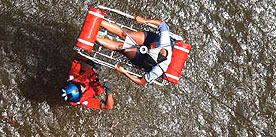
- Ensure that the pilot and ground personnel conduct a daily briefing to discuss the operating plan
- Do not overload helicopters
- Ensure that rigging equipment is inspected, rated for the load, and is protected from any sharp edges of the cargo being hauled
- Limit access/set up controlled access zones near the helicopter drop zone
- Ensure that communications are maintained between the load drop area and the helicopter
- Secure or remove loose gear within 100 feet of the place where a load is lifted or deposited
- Do not wear loose fitting clothing that may flap and get snagged on the hoist line
Key Engineering Controls and Work Practices
- Use grappling poles to retrieve floating objects; take caution around floating barrels and drums, which could release hazardous substances if punctured
- Use buoys to mark underwater diving locations or locations of submerged materials
- Use additional protections, such as a lifesaving skiff and a ring buoy, as appropriate
- See Deep-Water Work/Boating Operations activity sheet as needed
Additional Personal Protective Equipment
- Coast Guard-approved Type I or II personal floatation devices
- Watertight boots with steel toe and insoles as needed
Key Engineering Controls and Work Practices
- See the Diving and Diver-Support Operations activity sheet
Key Engineering Controls and Work Practices
- See Heavy Equipment and Powered Industrial Truck Use activity sheet
- See Crane Use activity sheet
- See Use of Aerial Lifts activity sheet
Additional Personal Protective Equipment
- Hearing protection—see Noise hazard
- When working from an aerial lift, use a body harness that is properly attached (or body belt for tethering or restraint use only) for fall protection
- ANSI/ISEA 107-2004 compliant high visibility safety apparel and headwear
Key Engineering Controls and Work Practices
- If hazardous chemical containers are found or leaking materials are detected:
- Do not use spark-producing devices (e.g., engines, tools, electronic, and communications equipment) in the immediate area
- Take self-protective measures (i.e., move to a safe distance upwind) and contact hazardous material response personnel for evaluation/removal before continuing work in the area
Additional Personal Protective Equipment
- Evaluate the need to revise protective clothing, respirator, and glove selection
Key Engineering Controls and Work Practices
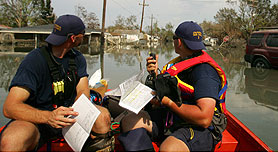
- Reduce the exposure to splash or aerosolized liquid hazards by limiting the number of people in the area and having those in the area stay upwind of water discharge areas
- Ensure that good hygiene, especially hand washing, is practiced before eating, drinking, and smoking. If clean water is not available, use an alternative such as hand sanitizer or sanitizing wipes
- Ensure that cuts and bruises are protected from contact with contaminated water
- Clean areas of the body that come in contact with contaminated water with soap and water, hand sanitizer, or sanitizing wipes
- If diving is required, ensure that divers and their equipment are appropriately decontaminated (fresh water shower/rinse at minimum) upon completion of dive operations – see Diving and Diver-Support Operations activity sheet
Additional Personal Protective Equipment
- Goggles if routinely working near splashing floodwater
- N, R, or P95 respirators may be necessary for exposure to contaminated water that may become aerosolized
- Watertight boots with steel toe and insoles
- Waterproof gloves for contact with contaminated water
Key Engineering Controls and Work Practices
- Inspect ladders for cracked, broken, or defective parts before use
- Do not exceed the load rating of ladders—remember that load ratings include people, tools, and equipment
- Set up ladders on stable surfaces
- Set extension or straight ladders at a 75 degree angle from the ground (1/4 foot back for every foot of rise) and provide 3 feet above an upper landing surface to ease climbing onto/descending from height
- Use non-conductive ladders (e.g., fiberglass) and exercise extreme caution when working near power lines
- Secure ladders that can be displaced by work activities; consider barricades at the base to keep traffic away
Key Engineering Controls and Work Practices
- Establish barriers/marks around areas of hazards as they are identified (holes, overhead hazards)
- Take extra care when stepping into areas that are unstable/uneven or where the surface cannot be seen
- See general recommendations document
Key Engineering Controls and Work Practices
- Stay upwind of or away from dust-generating activities, and in particular those involving crystalline silica-containing materials like concrete, brick, tile, drywall, mortar, sand, or stone. When inhaled, the fine crystalline silica particles contained in the dust can become lodged deep in the lung, which can lead to silicosis and other respiratory illnesses
- Use water spray or mist to suppress dust generation, especially during operations that may create a lot of dust, such as cutting or sawing silica-containing materials, jack hammering, impact drilling, using heavy equipment, and demolishing structures
- Avoid using compressed air for cleaning surfaces
- Sample worker exposures to silica during dust-generating activities
- Limit contact or disturbance of surfaces containing substantial visible mold growth
Additional Personal Protective Equipment
- At a minimum, use respirators with N, R, or P95 filters for work with crystalline silica-containing materials (e.g., concrete, brick, tile, mortar). The use of N, R, or P100 filters may provide additional protection. Higher levels of respiratory protection may be needed for some operations (e.g., cutting concrete, sandblasting, mixing concrete)
- N, R, or P95 respirators may be used for nuisance dusts (e.g., dried mud, dirt, or silt) and mold (except mold remediation). Filters with a charcoal layer may be used for odors
Key Engineering Controls and Work Practices
- Never attach a generator directly to the electrical system of a structure unless a qualified electrician has installed a transfer switch for the generator. If the structure's electrical system is not isolated, it may energize the utility's wiring system for great distances and create a risk of electrocution for utility workers and others in the area
- Always plug electrical equipment directly into the generator using the manufacturer's supplied cords or grounded (3-pronged) extension cords that are rated for the total anticipated load
- Do not overload a generator; it can overheat and create a fire hazard
- Ground and bond generators according to the manufacturer's recommendations; ensure that any manufacturer-required connections are secure before using the generator
- Keep the generator dry; protect with a canopy if needed; do not use it in wet or rainy conditions
- Carbon monoxide (CO) is a poisonous, colorless, and odorless gas that is produced by the incomplete burning of the generator's fuel. CO is harmful when breathed because it displaces oxygen in the blood and deprives the heart, brain, and other vital organs of oxygen
- Never use a generator indoors or in enclosed spaces such as garages and basements; opening windows and doors may not prevent CO from building up in those spaces. Do not use a generator outdoors near doors, windows, and vents that could allow CO to enter
- Ensure that a generator has 3 to 4 feet of clear space on all sides and above it to ensure adequate ventilation and cooling
- Before refueling, shut down the generator and allow it to cool
Additional Personal Protective Equipment
- Hearing protection-see Noise hazard
Key Engineering Controls and Work Practices
- Place generators, compressors, and other noisy equipment at a distance or behind a barrier when possible
Additional Personal Protective Equipment
- Hearing protection when working around potential noise sources and when noise levels exceed 90 dBA. A useful "rule of thumb"—if you cannot hold a conversation in a normal speaking voice with a person who is standing at arms length (approximately 3 feet), the noise level may exceed 90 dBA
Select any of the following potential hazards that can be associated with this activity in order to access relevant recommendations in the general recommendations document:
- Manual handling of materials/weight
- Cuts and lacerations
- Environmental hazards
Additional Medical Needs
- Follow medical guidance and precautions outlined in the general recommendations document
- Workers likely to contact blood and body fluids (medical and search and rescue personnel) should be vaccinated against hepatitis B
Additional Training Needs
- Follow general site- and task-specific training guidelines as outlined in the general recommendations document
- Workers who may be exposed to blood or other potentially infected materials (OPIM) through contact with bleeding, injured, or sick victims must be provided with initial and annual training on bloodborne pathogens and the employer's exposure control plan, in accordance with 29 CFR 1910.1030(g)
Related Activity Sheets
- Removing Human and Animal Remains
- Public Safety (Law Enforcement and Emergency Medical Services)
- Locating, Collecting, and Housing Stray Animals
- Diving and Diver-Support Operations
- Deep-Water Work/Boating Operations
- Entry into Confined Spaces
- Heavy Equipment and Powered Industrial Truck Use
- Crane Use
Other Resources and References
- 29 CFR 1910.1030, Bloodborne Pathogens. OSHA Standard.
- 29 CFR 1926.106, Working Over or Near Water. OSHA Standard.
- 29 CFR 1926 Subpart M, Fall protection. OSHA.
- 29 CFR 1926 Subpart X, Ladders. OSHA.
- 29 CFR 1910.1001, Asbestos in General Industry. OSHA Standard.
- 29 CFR 1926.1101, Asbestos in Construction. OSHA Standard.
- Respiratory Protection. OSHA Safety and Health Topics Page.
- NIOSH Respirator Selection Logic 2004. US Department of Health and Human Services (DHHS), National Institute for Occupational Safety and Health (NIOSH) Publication No. 2005-100, (October 2004).
- Search and Rescue Operations. OSHA Fact Sheet, (2005).
- Bloodborne Pathogens. OSHA Fact Sheets, (2011).
- Cleanup Hazards. OSHA Fact Sheet, (2005).
- General Decontamination. OSHA Fact Sheet, (2005).
- Working Safely Around Downed Electrical Wires. OSHA Fact Sheet (Publication 3941), (2018).
- Portable Ladder Safety Tips. OSHA Quick Card, (2005).
- Using Portable Generators Safely. OSHA Fact Sheet, (2005).
- Traumatic Incident Stress: Information for Emergency Response Workers. US Department of Health and Human Services (DHHS), National Institute for Occupational Safety and Health (NIOSH) Publication No. 2002-107, (October 2001).

